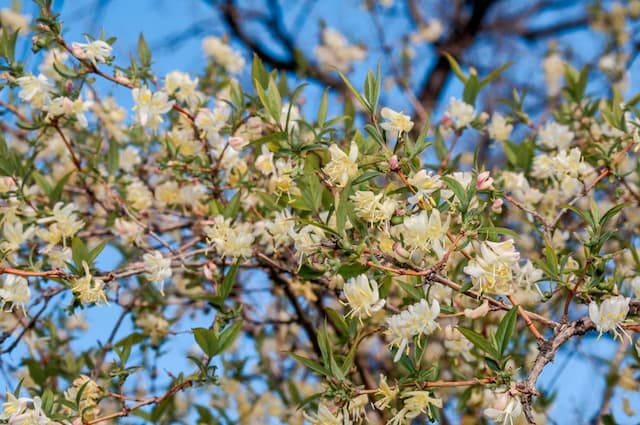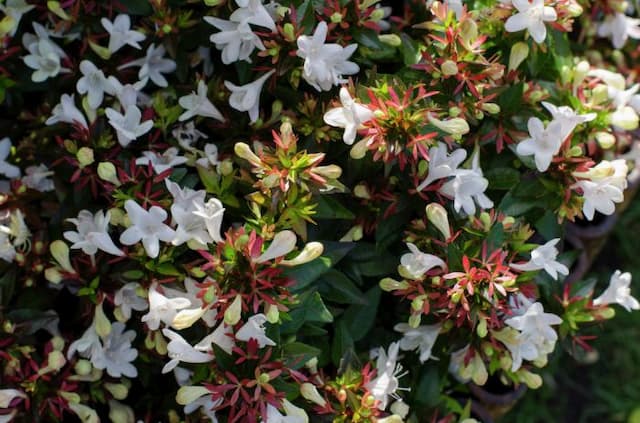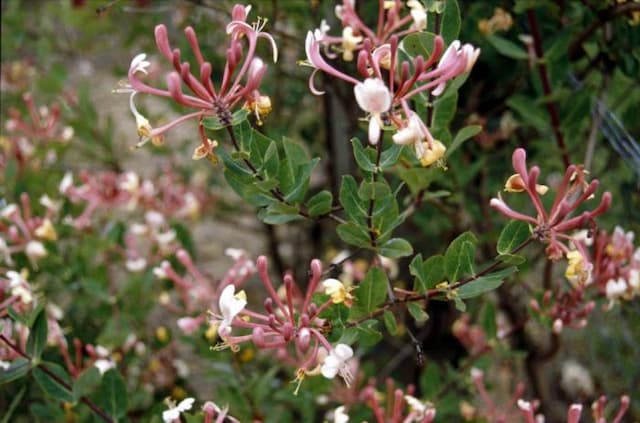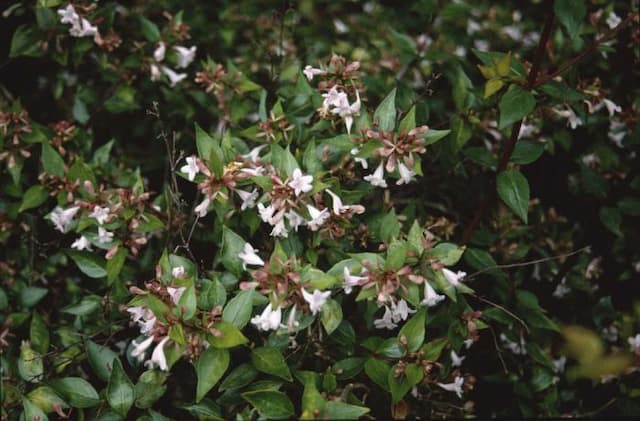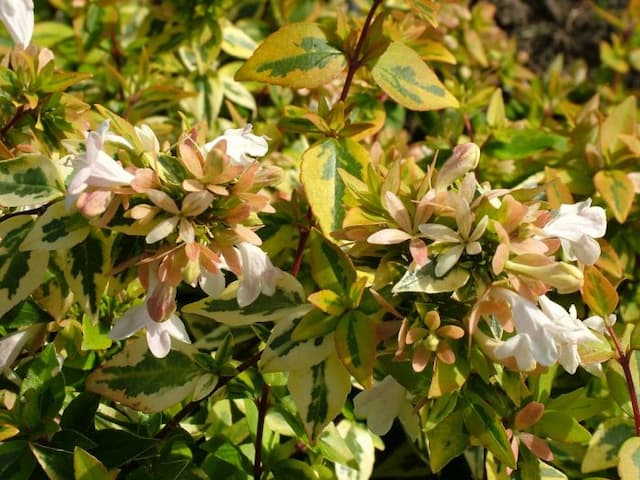Red valerian Centranthus ruber
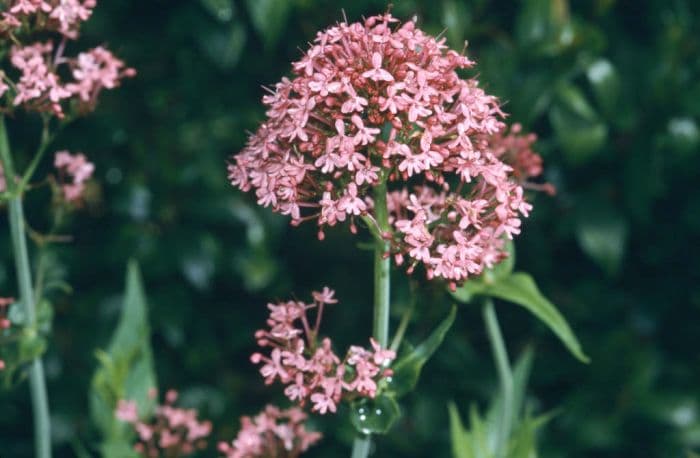
ABOUT
Centranthus ruber, widely known as red valerian, is a perennial plant boasting a profuse display of small, vibrant flowers that are typically a deep red or pinkish-red color, although white-flowered varieties can also be found. The flowers are tubular and appear in dense clusters at the top of branching stems, creating a frothy and eye-catching show throughout the blooming season. Red valerian’s leaves are a soft grey-green, fleshy, and lance-shaped, sometimes with a slightly toothed edge. The leaves are arranged opposite each other on the stems, gradually becoming smaller up towards the flowering stems. The plant often sports a bushy habit, with a verdant mass of foliage from which the flower stems rise and bloom. This abundant foliage and floral display contribute to red valerian's popularity as an ornamental plant in gardens. The overall effect of red valerian in bloom is a bold splash of color, which can attract various pollinators such as butterflies and bees.
About this plant
 Names
NamesFamily
Caprifoliaceae.
Synonyms
Red Valerian, Jupiter's Beard, Spur Valerian, Kiss-me-quick, Pretty Betsy, Fox's Brush.
Common names
Kentranthus ruber, Centranthus ruber var. coccineus, Centranthus ruber var. purpureus, Centranthus latifolius.
 Toxicity
ToxicityTo humans
Red valerian (Centranthus ruber) is not known for being toxic to humans. There is little evidence or documented cases of poisoning from consuming parts of this plant. However, as with any plant, individual sensitivities, such as contact dermatitis or allergic reactions, may occur in some people. It is generally recommended to avoid ingesting plants that are not commonly recognized as food, as they can cause an upset stomach or other gastrointestinal discomfort due to their unfamiliar chemistry.
To pets
Red valerian (Centranthus ruber) is not commonly listed as toxic to pets, such as cats and dogs. There is little information available that suggests this plant is harmful to pets, and it is not typically known for causing poisoning. However, every animal may react differently to various plants, and symptoms such as vomiting, diarrhea, or unusual behavior might occur if a pet ingests a substantial amount of the plant. If you suspect your pet is suffering from any symptoms after ingesting red valerian, it is best to consult a veterinarian.
 Characteristics
CharacteristicsLife cycle
Perennials
Foliage type
Semi-deciduous
Color of leaves
Green
Flower color
Red
Height
3 feet (0.91 meters)
Spread
2 feet (0.61 meters)
Plant type
Herb
Hardiness zones
5
Native area
Mediterranean
Benefits
 General Benefits
General Benefits- Ornamental Value: Centranthus ruber, commonly known as Red Valerian, has attractive, showy flowers that can add color and visual interest to gardens and landscapes.
- Drought Tolerance: Red Valerian is known for its ability to thrive in dry conditions, making it suitable for xeriscaping and water-wise gardens.
- Soil Adaptability: It is able to grow in a wide range of soil types, including poor and rocky soils, reducing the need for soil amendments.
- Pollinator Attraction: The flowers of Red Valerian attract bees, butterflies, and other pollinators, supporting local ecosystems.
- Low Maintenance: Once established, Red Valerian requires little maintenance, making it a convenient choice for gardeners with limited time.
- Fast Growth: Red Valerian grows quickly, allowing for rapid coverage and filling in garden spaces efficiently.
- Long Blooming Season: It has a long flowering period, which ensures prolonged ornamental appeal throughout the growing season.
- Erosion Control: Its extensive root system can help stabilize slopes and areas prone to erosion.
 Medical Properties
Medical Properties- Diuretic: Centranthus ruber is said to have diuretic properties, which means it may help promote the production of urine.
- Emmenagogue: According to some herbal tradition, the plant is believed to stimulate blood flow in the pelvic area and uterus, causing menstruation.
- Mild sedative: There are claims that Centranthus ruber may help to reduce anxiety and promote relaxation, acting as a sedative.
 Air-purifying Qualities
Air-purifying QualitiesThis plant is not specifically known for air purifying qualities.
 Other Uses
Other Uses- Centranthus ruber, commonly known as red valerian, can be used as a dye plant; its roots can produce a red or pink dye for fabrics or other materials.
- The flowers of red valerian can be added to salads or used as a garnish, providing a peppery flavor similar to that of garden cress.
- In landscaping, red valerian is often planted in cracks of walls or pavements, where it thrives with minimal soil, adding beauty to hard surfaces with its foliage and blooms.
- The plant can be used in floral arrangements, both fresh and dried, offering a long-lasting splash of color to bouquets.
- Red valerian is sometimes planted to stabilize soil and prevent erosion on slopes due to its robust root system.
- Gardeners use red valerian as a companion plant to attract beneficial insects, such as butterflies and bees, which are essential for pollination of surrounding plants.
- The strong and intense fragrance of the flowers can be used to make potpourris, providing a natural air freshener for homes.
- Red valerian can be used as a filler plant in garden beds to quickly cover bare spots, as it grows rapidly and spreads easily.
- Some culinary enthusiasts use the nectar-rich flowers to infuse syrups or liquors with a subtle, unique flavor.
- The robust nature of red valerian makes it suitable for xeriscaping, a landscaping method that requires minimal irrigation, thus conserving water.
Interesting Facts
 Feng Shui
Feng ShuiThe Red Valerian is not used in Feng Shui practice.
 Zodiac Sign Compitability
Zodiac Sign CompitabilityThe Red Valerian is not used in astrology practice.
 Plant Symbolism
Plant Symbolism- Affection: Often found in cottage gardens and informal settings, Centranthus ruber, commonly known as red valerian, is associated with heartfelt affection and a welcoming presence.
- Endurance: Red valerian is known for its ability to grow in challenging conditions, representing the trait of endurance and persistence in adverse situations.
- Ease of growth: Symbolizing effortlessness and simplicity, red valerian stands for the ease with which beauty and joy can be found or achieved in life.
- Spiritual healing: With its bright, clustered flowers, red valerian is thought to be a symbol of calmness and is sometimes associated with spiritual healing and balance.
 Water
WaterRed Valerian should be watered deeply yet infrequently, generally every 7 to 10 days, depending on the climate and soil conditions. You should aim to provide about 1 to 1.5 gallons of water for each plant during each watering session. It’s important to let the soil dry out between waterings to prevent root rot. During the hottest and driest parts of the summer, you may need to water more frequently. In the cooler months, or if there is rainfall, reduce the watering accordingly.
 Light
LightRed Valerian thrives in full sun conditions, where it can receive at least 6 hours of direct sunlight daily. It also tolerates partial shade, but flowering may be less abundant. The ideal spot for this plant is an area that is sunny and open, away from the shade of larger plants or buildings. Make sure it’s a spot where the plant can bask in unfiltered daylight for the majority of the day.
 Temperature
TemperatureRed Valerian, being a hardy plant, can tolerate a wide temperature range, surviving minimum temperatures down to around 0°F. The ideal growing temperatures for Red Valerian fall between 60°F and 75°F. However, the plant can endure summer heat exceeding 80°F without significant stress, provided it receives adequate watering.
 Pruning
PruningPruning Red Valerian encourages a denser growth habit and more bountiful flowering. Cut back the plant by one-third after the first bloom to promote a second flowering period. It’s ideal to prune in early spring to remove any dead or damaged growth from the winter. Perform general maintenance pruning as needed throughout the growing season to shape the plant and remove any leggy stems.
 Cleaning
CleaningAs needed
 Soil
SoilRed valerian thrives in well-draining soil with a neutral to slightly alkaline pH level, around 6.5 to 7.5. A soil mix that contains garden soil, compost, and sharp sand or gravel will provide the right conditions for growth and flowering.
 Repotting
RepottingRed valerian typically does not require frequent repotting and can be repotted every 2 to 3 years or as necessary when the plant outgrows its current container or the soil becomes exhausted.
 Humidity & Misting
Humidity & MistingRed valerian is tolerant of a wide range of humidity levels and does not have specific humidity requirements. It will grow well in average ambient outdoor humidity conditions.
 Suitable locations
Suitable locationsIndoor
Place red valerian near a sunny window and don't overwater.
Outdoor
Plant red valerian in full sun with good drainage.
Hardiness zone
5-9 USDA
 Life cycle
Life cycleRed valerian (Centranthus ruber) begins its life cycle when seeds germinate, typically in spring, preferring well-drained, loamy soils with full sun to partial shade. After germination, it develops a rosette of basal leaves and a deep taproot, which help it survive periods of drought. As the plant matures, it grows erect stems and lance-shaped leaves, reaching up to 60-90 cm in height. In late spring to summer, red valerian produces dense clusters of small, star-shaped pink, white, or red flowers, which are highly attractive to butterflies and bees. After pollination, typically by these insects, the flowers develop into small capsules containing numerous seeds that are dispersed by wind. Red valerian can act as a perennial or short-lived perennial, but it may also self-seed prolifically, ensuring its persistence in the garden or naturalized areas where conditions are favorable.
 Propogation
PropogationPropogation time
Spring to Summer
Centranthus ruber, commonly known as Red Valerian, is a flowering plant often propagated during the spring or early summer when the chance of frost has passed. The most popular method of propagation for Red Valerian is by seed. Seeds can be sown directly into a well-draining soil mix where they are to grow in the garden after the last frost date or started indoors 6 to 8 weeks before the last expected frost. When sowing, seeds should be lightly covered with soil as they require some light for optimal germination. The soil should be kept moist but not saturated to prevent seed rot. Seedlings usually emerge in 14 to 21 days at a temperature of approximately 65 to 70 degrees Fahrenheit (about 18 to 21 degrees Celsius). Once the seedlings are sturdy enough and the danger of frost has passed, they can be transplanted outdoors to their final positions, spaced about 12 to 18 inches (30 to 45 centimeters) apart to allow for adequate growth.
